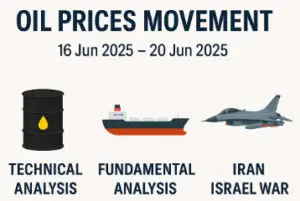Iran Israel War: How Escalating Tensions Are Shaking Global Oil Trading
As the world watches the Iran Israel War intensify, its impact on global markets is undeniable. Among the hardest-hit sectors is oil trading, where prices, supply routes, and investor sentiment are being shaken by the hour. What began as a regional confrontation is now sending ripple effects through every barrel, every port, and every trading floor from the Middle East to Wall Street.
This article breaks down what’s currently happening in the war, how it’s affecting global oil trading, and what traders, investors, and consumers can expect in the weeks ahead.
What’s Happening in the Iran Israel War? A Human and Economic Crisis Unfolding
The Iran Israel War is no longer a distant diplomatic standoff — it’s an active, escalating conflict that’s drawing global attention. As of mid-2025, the situation has turned from covert operations and indirect hostilities to open confrontation with widespread consequences, especially in the global oil trading markets.
In this article, we break down the timeline, key events, regional involvement, and how the war is influencing the global economy and oil markets.
The Spark That Lit the Flame
Tensions between Iran and Israel have existed for decades, but the current escalation began in late March 2025, after an Israeli airstrike on an Iranian consulate in Damascus, Syria. That attack killed high-ranking members of Iran’s Islamic Revolutionary Guard Corps (IRGC) and was viewed by Tehran as a direct attack on its sovereignty.
⚠️ April 13, 2025: Iran Responds — Openly and Directly
In a rare move, Iran responded not through proxies, but with a direct missile and drone strike on Israeli territory — the first such attack launched from Iranian soil in modern history. Over 300 projectiles, including drones and ballistic missiles, targeted Israeli cities and military bases.
Israel’s Iron Dome and allied defense systems, including support from the U.S. and UK, intercepted most of the missiles, but the symbolic escalation was significant. For the first time in decades, Iran and Israel were openly at war.
The Regional Domino Effect
The fallout has not been limited to just Tehran and Tel Aviv. The war has widened across the region, creating a volatile geopolitical environment.
🌍 Who’s Involved (Directly or Indirectly):
- Hezbollah (Lebanon): Has launched missiles into northern Israel in solidarity with Iran.
- Syrian territory: Continues to be used by Iranian militias and has been the target of several Israeli airstrikes.
- United States: While not officially in the war, the U.S. has intercepted Iranian missiles and increased its naval presence in the region.
- Gulf States: Nations like Saudi Arabia and the UAE are on high alert, fearing missile spillover and market instability.
This broadening conflict is placing enormous pressure on regional diplomacy and threatening wider military involvement.
Humanitarian Toll and Civilian Impact
Though much of the attention is on military movements, the human cost is growing rapidly.
- Israel has placed several cities under emergency alerts and carried out evacuations in high-risk zones.
- Iran has reported civilian casualties from retaliatory drone strikes in western regions.
- Lebanon and parts of Syria are experiencing increased displacement as airstrikes continue.
International bodies, including the United Nations and Red Crescent, have called for restraint, but the situation remains unstable.
The Iran Israel War’s Ripple Effect on Oil Trading
Perhaps the most immediate global consequence of the Iran Israel War has been its impact on oil trading.
🚢 Strait of Hormuz on Edge
The Strait of Hormuz, a vital chokepoint for nearly 20% of global oil supply, lies near Iran’s southern coast. As tensions rise:
- Oil tankers are being rerouted, delaying deliveries
- Insurance rates on Gulf shipments have more than doubled
- Speculators are pushing up oil futures
📈 Market Response
|
Date |
Brent Crude Price (USD) |
Market Reaction |
|
April 10 |
$86.70 |
Stable |
|
April 14 |
$96.30 |
Spike after Iran’s strike |
|
April 16 |
$101.70 |
Highest level since 2022 |
This surge in prices has rattled energy-importing countries and is putting pressure on inflation, especially in Europe and South Asia.
🔄 Trading Volume Surges
Energy trading platforms like ICE Futures Europe and NYMEX have seen up to 35% higher volumes since the outbreak. Traders are:
- Hedging long-term contracts
- Buying call options on crude
- Adjusting risk premiums on Middle East exposure
The oil trading ecosystem is now a barometer for geopolitical stability — and right now, it’s flashing red.
Diplomatic Efforts and Global Warnings
Despite mounting tension, world leaders are scrambling to prevent a full-scale regional war.
- U.S. Secretary of State Antony Blinken has held multiple emergency meetings with allies and Arab leaders.
- The European Union has called for de-escalation and warned about the economic fallout.
- China has urged both nations to avoid conflict escalation and preserve oil flow stability.
So far, diplomacy has had limited success, as neither side appears willing to back down without clear strategic gains.
What’s Next?
It’s hard to predict how long the Iran Israel War will last or how far it will spread. But here’s what seems likely in the near future:
- Continued tit-for-tat military operations
- Further disruption in oil logistics
- Rising global oil prices, possibly above $110 per barrel
- Increased market volatility across energy, defense, and commodities
Investors, analysts, and world governments are watching this conflict closely — because its outcome could reshape Middle East dynamics and global oil trading for years to come.
Final Thoughts
The Iran Israel War is more than a headline — it’s a deeply complex, high-stakes conflict affecting lives, economies, and energy markets. As missiles fly, borders heat up, and global leaders scramble for solutions, one truth remains: this war isn’t confined to the Middle East — it’s already being felt worldwide, especially at the gas pump and in the fast-moving world of oil trading. Whether peace or escalation follows, the world will remember 2025 as a year when two long-time enemies took the gloves off — and dragged the global economy into the crossfire.
Why Oil Trading Is So Sensitive to the Iran Israel War
At the heart of the conflict lies one of the world’s most crucial energy arteries: the Strait of Hormuz. Roughly 20% of the world’s oil supply — over 17 million barrels per day — passes through this narrow waterway between Iran and the Arabian Peninsula.
⛽ When a War Threatens a Chokepoint:
- Tanker insurance costs surge
- Shipping delays increase
- Exporters reroute, raising costs
- Traders panic-buy or hedge
The result? Volatile oil prices, massive speculation, and nervous trading activity across global energy markets.
Oil Prices React Instantly to War News
Following the initial strikes between Iran and Israel, oil prices jumped more than 15% in a matter of days.
|
Date |
Brent Crude Price (per barrel) |
Change |
|
April 10 |
$86.70 |
– |
|
April 14 |
$96.30 |
+11.1% |
|
April 16 |
$101.70 |
+5.6% |
The psychological barrier of $100 per barrel was crossed for the first time since mid-2022. Analysts say prices could easily climb to $120 or beyond if supply disruptions continue or if a wider regional war breaks out.
Short-Term Impacts on Oil Trading
🛢️ 1. Supply Chain Disruption
Even without direct damage to oil infrastructure, the threat of attacks on tankers has already:
- Slowed shipments from Kuwait, UAE, and Saudi Arabia
- Increased reliance on alternative shipping routes
- Caused European and Asian buyers to stockpile reserves
📈 2. Trading Volume Surge
Major exchanges like ICE Futures Europe and NYMEX saw oil trading volumes spike by over 40% in April as traders rushed to hedge positions and speculate on further price increases.
🧠 3. Sentiment-Driven Volatility
Oil markets are now being driven less by supply-demand fundamentals and more by fear, headlines, and speculation. This environment is ideal for day traders, but risky for long-term investors and physical buyers.
Strategic Reserves and Government Response
In response to price spikes and potential shortages:
- The U.S. Department of Energy announced a review of its Strategic Petroleum Reserve (SPR) release strategy.
- China reportedly began quietly increasing its crude purchases to stockpile reserves.
- India and Japan also signaled readiness to release emergency reserves if the situation worsens.
Governments understand that oil trading volatility doesn’t just affect energy — it affects inflation, food prices, and social stability.
Future Outlook: What Happens Next in Oil Trading?
The trajectory of oil prices and trading behavior will depend heavily on what happens in the coming weeks of the Iran Israel War.
📊 Three Possible Scenarios:
|
Scenario |
Oil Price Impact |
Market Behavior |
|
Ceasefire/De-escalation |
↓ Moderate correction |
Lower volatility, shift to fundamentals |
|
Limited Proxy War |
↔ Fluctuating |
Ongoing hedging, cautious trading |
|
Full Regional Escalation (e.g., with Hezbollah, Syria, or Gulf states) |
↑↑ Spike to $120+ |
Panic buying, potential rationing |
Most traders are bracing for the middle scenario: continued proxy warfare, occasional direct hits, and a slow bleed of uncertainty into the oil market.
Final Thoughts: Oil Trading in an Uncertain World
The Iran Israel War is not just a military conflict — it’s a global economic tremor. And nowhere is that more evident than in oil trading, where the price of peace is measured in dollars per barrel, and the cost of war is counted by every ship that hesitates to cross the Gulf.
Whether you’re a trader, an energy executive, or simply a consumer filling your tank, this war has made one thing clear: oil is not just a commodity — it’s a geopolitical weapon.
For now, the world waits, watches, and trades — barrel by barrel, headline by headline.
SEO-Optimized FAQs
Q1: How is the Iran Israel War affecting oil trading?
It has caused oil prices to surge and increased volatility due to fears of supply disruption in the Strait of Hormuz.
Q2: What’s the current oil price trend during the conflict?
As of mid-April 2025, Brent crude has risen over 15%, reaching above $101 per barrel.
Q3: Will oil prices go even higher if the war continues?
Yes, analysts warn that prices could reach $120+ per barrel if the conflict expands regionally.
Q4: How are oil traders responding?
By increasing hedging, shifting contracts, and speculating more heavily on short-term price movements.
Q5: Which countries are most affected in oil trading?
Middle Eastern exporters, Asian importers, and Western economies with high fuel dependence
Q6: What triggered the Iran Israel War?
An Israeli airstrike on an Iranian consulate in Syria escalated long-standing tensions into open warfare.
Q7: How is the Iran Israel War affecting oil trading?
Oil prices have surged due to risks in the Strait of Hormuz, impacting global shipping, supply, and trading volume.
Q8: Which countries are most impacted by the conflict?
Besides Iran and Israel, Lebanon, Syria, the U.S., and Gulf countries are feeling political and economic pressure.
Q9: Are oil prices expected to keep rising?
Yes, if the war continues or widens, analysts expect Brent crude to exceed $110 per barrel.
Q10: What is the global response to the war?
World powers are urging de-escalation, but no major diplomatic breakthrough has been achieved yet.



